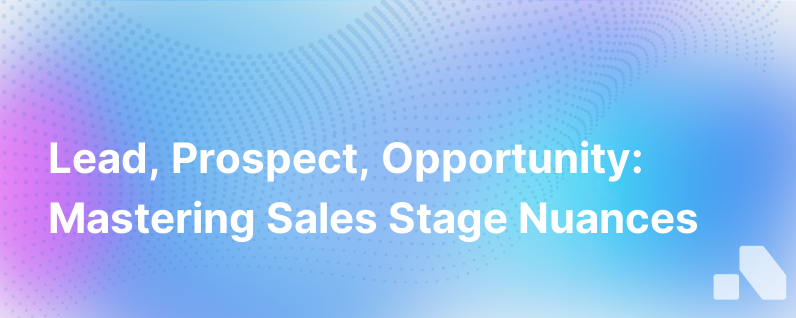Lead Vs Prospect Vs Opportunity
Published on September 30, 2023 by David Zhang
In the bustling arena of sales, the terminology often becomes a web of lingo that, if not properly understood, can tether the most ardent sales teams into knots of confusion. A significant part of this conundrum revolves around three cornerstone concepts: leads, prospects, and opportunities. Each term signifies a different stage in the sales process and understanding the nuances can be the fulcrum on which a sales strategy pivots.
Leads: The Starting Blocks in the Sales Relay
Leads are the data-driven hints of potential interest in your service or product—your starting point. They can be generated through various channels, including marketing campaigns, trade shows, webinars, and website traffic. The defining characteristic of a lead is that it represents a person or entity that might not have expressed a clear interest in making a purchase but has been identified through their actions or demographic data as matching the profile of a potential customer.
Imagine a scenario where a company employs web forms to collect information—those individuals who download a white paper or subscribe to a newsletter are turning themselves into leads. They've given you their contact information (after being attracted by your content), suggesting that they’re ready for the first, gentle push from your end. However, bear in mind that not all leads are created equal. They can range wildly in quality, based on how likely they are to become paying customers. This quality can be assessed by lead scoring mechanisms that evaluate their engagement level and readiness to proceed further in your sales funnel.
Prospects: Sifting Gold from the Sand
Prospects are your vetted leads. These individuals or companies have been contacted or have engaged with your sales team and have taken actions that indicate an interest in your offerings. They've started the conversational dance—a step beyond just leaving their digital calling card. This is the stage of exploring whether their challenges align with the solutions you provide, whether it’s a fit.
A prospect is akin to a candidate who has moved past the resume screening for a job and is now in the interview process. It’s about reciprocal evaluation—do their needs match your capabilities? Have their pain points been accurately identified?
Prospects are not assured customers, but there is mutual intrigue. The sales team's role at this juncture is to nurture that interest, to court the prospect with targeted communication, to educate, engage, and elucidate the benefits of your offering. This phase encompasses multiple interactions where the buyer’s intent, budget, authority, needs, and timeframe (BANT) are usually established.
Opportunities: The Dawn of Potential Sales
An opportunity is a qualified prospect—a beacon that suggests a deal that might be nearing the horizon. It's not a closed sale yet, but it's a glimmering chance. This stage is a leap forward from the prospect phase because, by now, the prospect has demonstrated a clear intent to buy, has the budget allocated, and has perhaps requested a proposal or a demo.
At this point, an opportunity should be integrated into your Customer Relationship Management (CRM) system, moving down the sales funnel ushered by tactical precision. There’s an ongoing discourse, pitches are being tailored, and terms are being negotiated.
Opportunities call for careful weaving of insights into compelling reasons for why the prospect would benefit from purchasing your product. It’s about nurturing, convincing, and sometimes waiting with bated breath for the prospect to ink their commitment onto a contract.
Transitions: From Lead to Prospect to Opportunity
How does a lead become a prospect, and how does a prospect mature into an opportunity?
-
Qualification: The initial shift happens through lead qualification. Using criteria set by your organization, sales and marketing teams assess which leads have the potential to purchase. Tools like lead scoring can help automate this process.
-
Engagement: Once qualified, personalized engagement with the prospect is key. This could involve follow-up emails, phone calls, product demos, or meetings. Nurture your leads effectively, and they'll blossom into prospects.
-
Needs Analysis: Understanding your prospect's specific needs, pain points, and how your product or service can address them creates opportunities. Effective needs analysis can transform a prospect into a hot opportunity through demonstration of value.
-
Follow-up and Nurture: Both prospects and opportunities require consistent follow-up. The method through which a salesperson nurtures the relationship will vary based on the buyer’s stage in the journey.
Each interaction with a lead, prospect, or opportunity should be logged meticulously. Utilization of a CRM system is essential in tracking these engagements and analyzing sales cycle lengths, win rates, and conversion ratios. With the recent advancements in sales automation, platforms like Aomni offer cutting-edge solutions to accurately pinpoint the stage of each potential customer and facilitate the right sort of engagement, enabling a swift yet seamless journey from being a lead to becoming an opportunity.
The Golden Thread of Sales Success
Understanding the delicate demarcations between leads, prospects, and opportunities is akin to recognizing the nuances in a fine melody—each note has its place and timing. In the concert of sales, leads require intrigue and attraction, prospects necessitate nurturing and alignment, and opportunities demand negotiation and closure.
By recognizing where each potential buyer is in the sales process, teams can deploy the appropriate strategies to move them down the funnel—from the initial lead engagement all the way through to the crowning glory of clinching an opportunity. The processes of engagement, qualification, and nurturing are not isolated—they form a continuum of interaction, data, feedback, and refinement that aligns sales efforts with customer readiness.
With adept handling, insight, and the right tools, the jargon of leads, prospects, and opportunities translates into a harmonious strategy that leads to closed deals and enduring business relationships. When aligned with advanced platforms like Aomni that deliver actionable competitive insights and personalized sales content, the path from a lead to an opportunity becomes not only more navigable but also more fruitful.